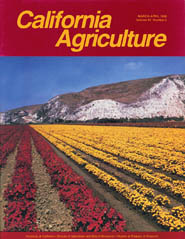All Issues

Cover:
Huge fields of flowers being grown for seed, such as these marigolds and petunias, are common sights in the Lompoc Valley of California near Santa Barbara. Marigolds are also grown for seed in large commercial greenhouses, where the leafminer is a pest. This article reports on the use of a parasitic wasp to control leafminers in greenhouse marigolds. Photo courtesy Bodger Seeds, Ltd., of Lompoc.
March-April 1988
Volume 42, Number 2
Volume 42, Number 2





